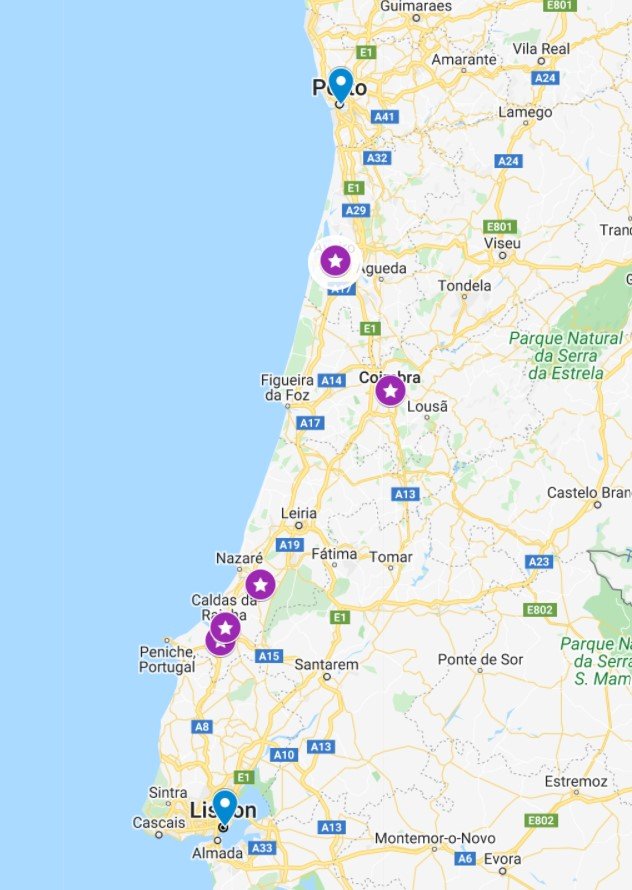Driving Between Lisbon and Porto? Don’t Miss These Cool Stops Along the Way
Lisbon and Porto are Portugal’s two biggest cities, and they’re about 3 hours apart. Traveling between the two is extremely convenient by train or bus if the destination is more important than the journey. But if you’re looking for a little more freedom to explore at your leisure, driving is not only a viable option but a completely enjoyable one as well.
Cool Stops between Lisbon and Porto
So you’re in your rental car, your road trip playlist is cued up, and your favorite travel snacks are within arm’s reach. Since Lisbon and Porto are just 200 miles apart, you can easily make the journey in a day, even with a stop or two. But there are several towns and cities that offer a totally different experience of Portugal along the way, and if you have time to spare, it’s worthwhile to spend a night or two en route to make the most of the journey. Here are several fun stops to consider, listed in northbound order. Find a couple that pique your interest, or use them as jumping off points for a more deluxe Portugal road trip.
Óbidos
1 hour from Lisbon
2 hours from Porto
Castle of Óbidos
A typically colorful street in Óbidos
The journey from Lisbon to Óbidos is about 53 miles (83 km) and is pleasantly short. Óbidos is a walled, medieval town on a hill, with narrow cobblestone streets laced between quaint white houses topped with terracotta tiled roofs, and a well-preserved castle. The castle was once an outpost for the Roman Legions, placed on a cliff as its architectural centerpiece.
Book lovers must pay the Literary Man Hotel a visit, where bookshelves line the warm and inviting space. Even if you’re not spending the night there, it’s a perfect stop for a meal or a literary-themed drink, while you peruse the bookstore and library. Óbidos is also home to a famous chocolate festival, which usually takes place in the spring. If you’re lucky enough to visit during the festival, you’ll find large chocolate sculptures, demonstrations and exhibitions around the Castle of Óbidos.
A stunning, tall ivy-covered wall in Óbidos
Local cuisine features bouillabaisse made with fish from the Óbidos Lagoon. Wines from the region of Oeste are plentiful, and Ginjinha de Óbidos, a local sour cherry brandy best consumed out of small chocolate cups, is a must-try. Walk it all off as you wander the scenic streets and alleys, with untold delights around every corner.
Pro Tip: Finding parking in Óbidos can be tricky, as there’s no parking or driving within the city walls. There are a couple of paid parking lots on the outskirts of town, which is likely the best course of action. You can park for free on the winding ascent leading to the castle grounds, along a harrowingly narrow roadway. If you’re traveling with luggage and valuables in your vehicle, we recommend a more secure option.
Caldas da Rainha
67 minutes from Lisbon
125 minutes from Porto
Museu da Cerâmica exterior
Museu da Cerâmica interior displays
At a similar distance, Caldas da Rainha is a mere 57.5 miles (92.5 km) from Lisbon. If you’re coming from Óbidos, the city is less than 15 minutes away. Caldas da Rainha, a modest-sized town in the Oeste Region, District of Leiria, is named for the area’s sulfurous hot springs and Queen Rainha Dona Leonor, who founded the settlement and established a hospital and church on the site in the 15th century. The town is home to nine museums, but the famed Museu da Cerâmica is its crown jewel.
Caldas da Rainha is a principal city of Portuguese pottery. In 1884, artist and national treasure Rafael Bordalo Pinheiro opened Fábrica de Faianças, which churned out intricate azulejos, panels, fountain basins, table centerpieces, kitchenware, and more. The factory still produces a variety of its iconic cabbageware and greenware, figurines, and fanciful pottery. Museu da Cerâmica packs an impressive collection of ceramic artifacts into a surprisingly compact space. It traces the national history and influences, acquainting visitors with well-known artists and styles through the ages. It’s well worth a visit.
Street art by AddFuel
For those interested in street art, murals abound thanks to the FALU Festival, which was first held in 2020 and included murals from such Portuguese heavy-hitters as Bordalo II, Add Fuel, Akacorleone, Daniel Eime and Nuno Viegas. You can explore some of these artists’ works in our street art guide to Lisbon.
Alcobaça
90 minutes from Lisbon
2 hours from Porto
Monastery of Santa Maria de Alcobaça
Alcobaça Monastery church interior and rose window
Alcobaça is approximately 72.5 miles (115 km) from Lisbon and just 30 minutes from Caldas da Rainha. Its unparalleled Monastery of Santa Maria de Alcobaça is both a masterpiece of Cistercian Gothic architecture and a UNESCO World Heritage Site. Modeled after the Abbey of Claraval, the headquarters of the Cistercian Order in France, the monastery rivaled the greatest European abbeys in size and wealth during the Middle Ages.
Carved tombs of King Peter I and his mistress, Inês de Castro, memorialize one of Portugal’s greatest tragic love stories. In opposition to their union, King Afonso IV had Inês murdered, decapitating her in front of her small child. Peter sought out the killers and executed them publicly. As the legend goes, Peter exhumed Inês’s corpse and conducted a post-mortem coronation, making her his queen. Inês de Castro has inspired myriad art, music, and drama through the ages. For any traveler with a love of art, architecture, or history, this monastic complex is unquestionably a necessary stop.
Specialty pastries including Inês Diary, Delicacy of the Gods, and the popular Cornucopia at Pastelaria Alcôa
And while we don’t ever need an excuse to indulge in delicious pastries, Pastelaria Alcôa is more than a stop for coffee and dessert. Located just across the street from the monastery, this renowned bakery has been around since 1957 and has played a significant role in preserving the country's gastronomical heritage. Its owner, Paula Alves, has devoted her life to researching and resurrecting “convent sweets”, unique delights developed in the monasteries all over Portugal. Many feature regional touches and were passed down simply by word of mouth. You’ll be dazzled by the selection the second you step foot into the store, and even more so once you taste the delicate flavors and textures of their award-winning pastries.
Pro Tip: If you have additional time to spare, consider visiting all three sites on the Heritage Route: the Monastery of Batalha and the Convent of Christ in Tomar. They are only approximately 30 mins apart, though from Alcobaça you would be traveling further east, requiring a bigger detour from the Lisbon to Porto route.
Coimbra
2 hours from Lisbon
70 minutes from Porto
Royal Chapel of San Miguel at University of Coimbra
Coimbra is approximately 130 miles (210 km) from Lisbon, or a little over an hour away from our Alcobaça. Coimbra is one of Portugal’s most charming historic cities, nestled on the bank of the Mondego River. The University of Coimbra, which was founded in 1290, is the oldest in the country and still one of its most prestigious.
You may wander the university campus freely, but tickets are required to visit some of its best treasures. The Joanina Library is regarded as one of the most beautiful in the world, with its luxe baroque design, tall ceilings and oak wood shelves. Fun fact: bats inhabit the Library to assist with pest control (!), though you won't catch a glimpse of the nocturnal animals while you’re there. Access is by timed entry only, and your visit is limited to 15 minutes. The short visit is more than enough to catapult you into a reverie, but don’t forget to take a mental picture since no photos are permitted. While on campus, make time for the stunning Royal Chapel of San Miguel as well as the Royal Palace, which also offers access to magnificent city views. And weather permitting, enjoy a stroll in the picturesque Botanical Garden.
Monastery of Santa Cruz
Chapel at Monastery of Santa Cruz with 18th century pipe organ
In the city center, don't miss the Monastery of Santa Cruz, one of our favorite stops in all of Portugal (which is saying a lot!). Built in the 12th century and painstakingly restored in the 16th century, it is considered a crown jewel of Portuguese Renaissance design. The azulejos are stunning, and the space manages to feel resplendent yet reverential. Coimbra’s other worthy attractions include the Monastery of Santa Clara-a-Velha, and the Sé Velha (the Old Cathedral).
Pro Tip: During the school term, the University of Coimbra students dress in a cape and gown. Some Harry Potter fans liken the experience to being at Hogwarts. While we won’t recommend against photographing the students in uniform, we do recommend asking for permission before doing so. By all accounts, the students are likely to accommodate.
Aveiro
2.5 hours from Lisbon
45 minutes from Porto
Colorful moliceiros boats on the Aveiro canal
Bridge of Friendship tied with colorful ribbons
Aveiro, often referred to as the “Venice of Portugal”, is a coastal seaport located on the shores of the Atlantic. Its strategic importance dates back to the Middle Ages as a center of trade and salt production and later for the harvest of moliço seagrass, which was used as an early form of fertilizer. The economy today is focused on ceramics production, software development, and tourism.
With its gorgeous beaches and dunes, picturesque town square, modern retail park, and myriad restaurants and cafes, Aveiro feels more like a vacation destination than anywhere else we visited. There’s an inescapable sense that the stranger passing you by has shed his daily armor, liberating a more relaxed, buoyant version of himself. The colorful gondola-like moliceiros (flat-bottomed boats) are one of the city’s most popular attractions. A 45-minute ride offers a unique way to explore Aveiro’s famous landmarks, and is clearly an activity enjoyed by locals and visitors alike.
Sunset over the canal
We chose to stroll along the network of canals and enchanting bridges. The Carcavelos Bridge bears a striking resemblance to the famous Venetian footbridges, but is decorated with Portuguese tilework and the city's coat of arms. Ponte Laços de Amizade, or the Bridge of Friendship, features eye-catching ribbons that flutter in the breeze. Then we ended the day enjoying one of the most vivid sunsets of our lives.
Tips for Driving in Portugal
We know driving in a foreign country can be daunting, so here are some tips for driving in Portugal that we picked up along the way.
Minimize in-city driving as much as possible
Although we’ve done a lot of city driving, we still wanted to limit driving in Lisbon and Porto as much as possible. As with most cities, both are best explored on foot or using public transportation like the electricos or subways. This also reduces the need to navigate complicated parking ordinances.
Dust off your manual transmission driving skills
When we made our car rental reservations, we found limited availability of automatic transmission cars. If this is a deal breaker for you, look to busier airport locations for more options. Reserve your chosen vehicle, and select an early pick-up time to minimize the risk of the location running out of cars. Also note that on busy days, the agency may not allow you to pick up your car prior to your scheduled reservation.
Request a Via Verde toll transponder
Avoid having to stop at individual toll booths by asking the rental car company for an electronic toll transponder. This gives you access to Via Verde highway express lanes. Toll payments are then tracked electronically, and charged to your credit card by the rental car agency. To estimate your costs in advance, you can use this toll simulator.
Fuel up like a pro
Petrol taxes are high in Portugal, so you can expect it to translate into larger costs at the pump. Advise the attendant if you want standard (95) or premium (98). And if you’re paying with a credit card, let them know upfront. We didn’t encounter any issues, but it’s always good to be sure or to have cash handy, just in case. Also note that petrol stations or kiosks in Portugal don’t generally operate 24 hours a day, so don’t wait to fill your tank.
Master the roundabout
Roundabouts are fairly uncommon in the United States, but they are used widely in Portugal. Traffic circulates counterclockwise, so you should always yield at the entry to circulating traffic from the left. But don’t fret if you miss your exit, you can just circle the roundabout again and get it right the next time!
Conclusion
Lisbon and Porto, each in their own right, offer so many incredible things to see and do that it’s easy to neglect the miles between them when developing your itinerary. But that would be a mistake. The various districts, smaller cities, and towns offer important links to Portuguese culture and history that differ from those of the major cities. Driving will certainly include some unexpected challenges but also many, many rewards.


















